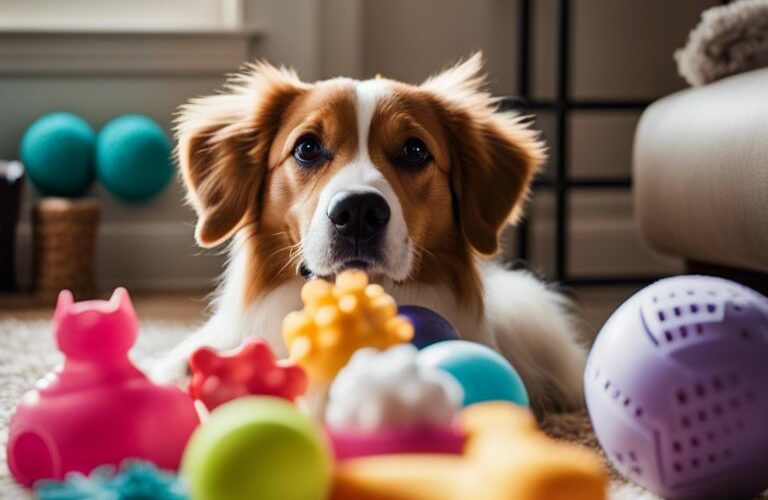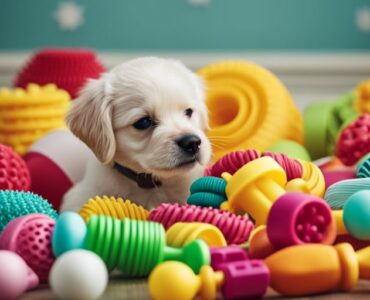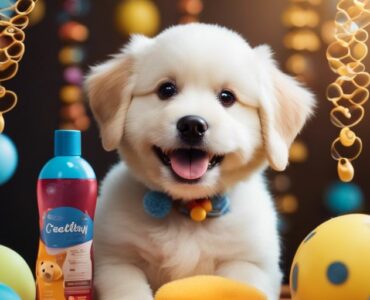Canine playthings, much like any other possessions, necessitate *regular maintenance* to ensure they remain safe for your furry companions. Proper upkeep of these items not only extends their longevity, but also safeguards your pet’s health and well-being. Regular washing and disinfecting are crucial to prevent the accumulation of bacteria and germs on the toys, which can pose a serious health risk to your pet. It is also important to routinely inspect the toys for any signs of wear and tear, such as loose parts or broken pieces, which could potentially harm your dog during playtime. By taking the time to properly maintain your dog’s toys, you are ensuring that they can continue to enjoy them in a safe and healthy manner.
Table of Contents
Key Takeaways:
- Cleaning is essential: Regular cleaning of dog toys is crucial to prevent the buildup of dirt, bacteria, and germs that can pose health risks to your pet.
- Inspect for wear and tear: It’s important to regularly check your dog’s toys for any signs of damage, such as loose parts, torn fabric, or sharp edges, to prevent potential hazards.
- Replace when necessary: When dog toys show signs of wear and tear beyond repair, it’s important to replace them to ensure the safety of your pet during playtime.
- Choose durable materials: Opt for dog toys made from high-quality, durable materials that can withstand your pet’s chewing and play habits, reducing the need for frequent replacements.
- Rotate toys regularly: Keeping a rotation of toys allows for variety and can help prolong the lifespan of each toy, as well as keeping your dog engaged and entertained.
Daily Maintenance Routines
One of the essential aspects of keeping your dog’s toys in good condition is to establish a daily maintenance routine. Regularly cleaning and inspecting the toys will not only extend their lifespan but also ensure the safety of your furry friends.
Cleaning Surface Dirt and Saliva
Daily cleaning of your dogs’ toys is essential to remove dirt, saliva, and other debris that may accumulate on the surface. Use a mild pet-safe soap and warm water to gently scrub the toys and then rinse thoroughly. Allow the toys to air dry completely before giving them back to your pups.
Another option for cleaning plush toys is to put them in a mesh laundry bag and run them through a gentle cycle in the washing machine. Make sure to remove any detachable parts, such as squeakers, before washing and always follow the manufacturer’s guidelines for cleaning.
Inspecting Toys for Damage
For toys made of rubber or plastic, it is important to check for any signs of damage daily. Look for cracks, punctures, or pieces that may have become loose. Inspecting the toys for damage helps to prevent your dogs from ingesting small parts, which can pose a choking hazard or cause intestinal blockages.
Toys that are showing excessive wear and tear should be discarded and replaced with new ones. Additionally, keep an eye out for any sharp edges or rough surfaces that could potentially harm your dogs while playing.
Weekly and Monthly Maintenance Tasks
If you want to keep your dog’s toys in good shape and ensure they remain safe for playtime, regular maintenance is essential. Weekly maintenance tasks may include checking for signs of wear and tear, removing any accumulated dirt or debris, and inspecting for loose parts that could pose a choking hazard. On a monthly basis, it’s important to give the toys a more thorough cleaning and disinfecting to prevent the buildup of bacteria and germs.
Disinfection Techniques for Different Materials
On a monthly basis, it’s important to thoroughly clean and disinfect your dog’s toys. The disinfection process will vary depending on the material of the toy. For rubber or hard plastic toys, you can soak them in a solution of water and mild detergent, then rinse and air dry them thoroughly. For soft fabric toys, they can be machine washed on a gentle cycle with a pet-safe detergent, and then air dried completely.
Repairing and Restuffing Toys
Toys that have been heavily chewed or torn may need some repair and restuffing to extend their lifespan. For plush toys, you can stitch up any tears and replace the stuffing with pet-safe filling. For hard toys, you may need to use a pet-safe adhesive to mend any cracks or breaks, or replace them if the damage is severe.
Disinfection is essential after performing any repair or restuffing tasks to ensure the toys remain clean and safe for your pets to play with. Regular inspection and maintenance can help prevent the need for extensive repairs in the future.
Seasonal Considerations and Storage
Keep your dog toys in top condition by considering seasonal changes and proper storage solutions. This will ensure that your dog’s toys remain safe and enjoyable for them to play with.
Seasonal Toy Rotation and Care
Care for your dog toys by rotating them seasonally to avoid wear and tear. For example, during the summer months, consider using more water-resistant toys to prevent mold and mildew growth. In the winter, focus on toys that can withstand the cold and snow without getting damaged. Regularly inspect and clean toys to prevent any potential hazards to your furry companions.
Appropriate Storage Solutions for Longevity
Solutions for appropriate storage include using airtight containers to prevent exposure to moisture and bacteria. This will extend the longevity of the toys and keep them safe for your dogs to use. Additionally, consider storing toys in a designated area to avoid clutter and potential accidents.
This ensures that your dog toys remain safe and enjoyable for them to play with. By implementing these storage solutions, you can prevent potential hazards and extend the lifespan of your dog’s toys, keeping them in top condition for your furry friends to enjoy.
Safety Tips and Replacement Guidelines
Despite durable dog toys being designed to withstand chewing and rigorous play, it is important to regularly check them for signs of wear and tear. This will help prevent potential hazards to your pets. Here are some safety tips and replacement guidelines to keep in mind:
- Inspect toys regularly for any signs of damage, such as torn seams or small, easily ingestible parts.
- Replace any toys that have become worn down or damaged to prevent choking or digestive issues.
- Avoid giving toys with small parts or loose fibers to dogs that are prone to destructive chewing.
Assume that dogs will eventually wear down any toy, no matter how durable it claims to be. It is better to be safe than sorry when it comes to your pet’s safety.
When to Discard and Replace Toys
An essential part of maintaining your pet’s toy collection is knowing when to discard and replace them. As dogs play with their toys, they can start to break down and become potential hazards. It is important to frequently check for any signs of damage, including loose fibers, holes, or cracks. If you notice any of these, it is time to discard the toy and replace it with a new one.
Choosing Durable Toys to Reduce Maintenance
Toys that are made from quality materials and designed for aggressive chewers can significantly reduce the amount of maintenance required. Look for toys that are made from durable rubber, nylon, or rope to increase the longevity of the toy and minimize the need for frequent replacement.
Toys that are specifically labeled as indestructible or heavy-duty are also great options for dogs that are particularly rough on their toys. These toys are built to withstand even the most aggressive chewing and play, reducing the likelihood of damage and increasing safety for your pet.
Conclusion
Drawing together all the information on the maintenance of dog toys, it is clear that regular cleaning and inspection are crucial for ensuring the safety and longevity of these items. Depending on the material and usage, toys may need to be washed, disinfected, and repaired as necessary. It is important to replace worn out or damaged toys to prevent potential harm to your dog. By understanding the specific needs of different toys and taking the time to properly care for them, pet owners can ensure that their furry friends have a safe and enjoyable playtime experience.
FAQ
Q: How often should dog toys be cleaned?
A: Dog toys should be cleaned regularly, ideally at least once a week. This will help prevent the buildup of dirt, bacteria, and other contaminants that can be harmful to your dog’s health.
Q: What is the best way to clean dog toys?
A: The best way to clean dog toys depends on the material. For rubber or plastic toys, they can be washed with warm soapy water and a mild detergent. Fabric toys can be machine washed or hand washed with a pet-safe detergent. Be sure to thoroughly rinse and air dry all toys before giving them back to your dog.
Q: Are there any maintenance tips for keeping dog toys in good condition?
A: To extend the life of your dog’s toys, it’s important to regularly inspect them for signs of wear and tear. If a toy is damaged, it should be replaced to prevent any potential harm to your dog. Additionally, rotate your dog’s toys regularly to keep them engaged and interested, and store them in a clean, dry place when not in use.










Add comment